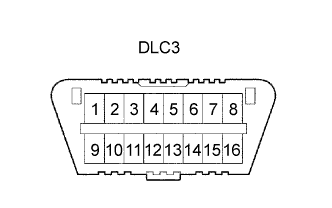Sfi System Diagnosis System
DESCRIPTION FOR M-OBD
NORMAL MODE AND CHECK MODE
2 TRIP DETECTION LOGIC
FREEZE FRAME DATA
CHECK DLC3
INSPECT BATTERY VOLTAGE
CHECK MIL
Sfi System -- Diagnosis System |
When troubleshooting Multiplex OBD (M-OBD) vehicles, the vehicle must be connected to the intelligent tester. Various data output from the vehicle's Engine Control Module (ECM) can then be read.
The Malfunction Indicator Lamp (MIL) is illuminated when the vehicle's onboard computer detects a malfunction in the computer itself or in drive system components. In addition, the applicable Diagnostic Trouble Codes (DTCs) are recorded in the ECM memory (Toyota Fortuner RM0000017Y3003X.html).
If the malfunction does not reoccur, the MIL stays illuminated until the ignition switch is turned OFF, and then the MIL turns OFF when the ignition switch is turned ON. However, the DTCs remain recorded in the ECM memory.
To check the DTCs, connect the intelligent tester to the Data Link Connector 3 (DLC3) on the vehicle, or connect terminals TC and CG on the DLC3 (DTCs will be displayed on the combination meter).
| NORMAL MODE AND CHECK MODE |
The diagnosis system operates in "normal mode" during normal vehicle use. In normal mode, 2 trip detection logic is used to ensure accurate detection of malfunctions. "Check mode" is also available to technicians as an option. In check mode, 1 trip detection logic is used for simulating malfunction symptoms and increasing the system's ability to detect malfunctions, including intermittent malfunctions (Toyota Fortuner RM000000PDL017X.html).
When a malfunction is first detected, the malfunction is temporarily stored in the ECM memory (1st trip). If the ignition switch is turned OFF and then ON again, and the same malfunction is detected again, the MIL will illuminate (2nd trip).
Read freeze frame data using the intelligent tester. Freeze frame data records the engine conditions when a malfunction is detected. When troubleshooting, freeze frame data can help determine if the vehicle was running or stopped, if the engine was warmed up or not, if the air-fuel ratio was lean or rich, and other data from the time the malfunction occurred.
The vehicle's ECM uses the ISO 14230 (M-OBD) communication protocol. The terminal arrangement of the DLC3 complies with ISO 15031-03 and matches the ISO 14230 format.
If the result is not as specified, the DLC3 may have a malfunction. Repair or replace the harness and connector.
Symbol
(Terminal No.)
| Terminal Description
| Condition
| Specified Condition
|
SIL (7) - SG (5)
| Bus "+" line
| During transmission
| Pulse generation
|
CG (4) - Body ground
| Chassis ground
| Always
| Below 1 Ω
|
SG (5) - Body ground
| Signal ground
| Always
| Below 1 Ω
|
BATT (16) - Body ground
| Battery positive
| Always
| 9 to 14 V
|
- HINT:
- Connect the cable of the intelligent tester to the DLC3, turn the ignition switch ON and attempt to use the tester. If the display indicates that a communication error has occurred, there is a problem either with the vehicle or with the tester.
- If communication is normal when the tester is connected to another vehicle, inspect the DLC3 on the original vehicle.
- If communication is still not possible when the tester is connected to another vehicle, the problem is probably in the tester itself. Consult the Service Department listed in the tester's instruction manual.
If voltage is below 11 V, recharge or replace the battery before proceeding.
- Standard battery Voltage:
- 11 to 14 V
The MIL illuminates when the ignition switch is turned ON and the engine is not running.
- HINT:
- If the MIL does not illuminate, troubleshooting the MIL circuit (Toyota Fortuner RM000000WZ100XX.html).
When the engine is started, the MIL should turn off. If the MIL remains illuminated, the diagnosis system has detected a malfunction or abnormality in the system.



